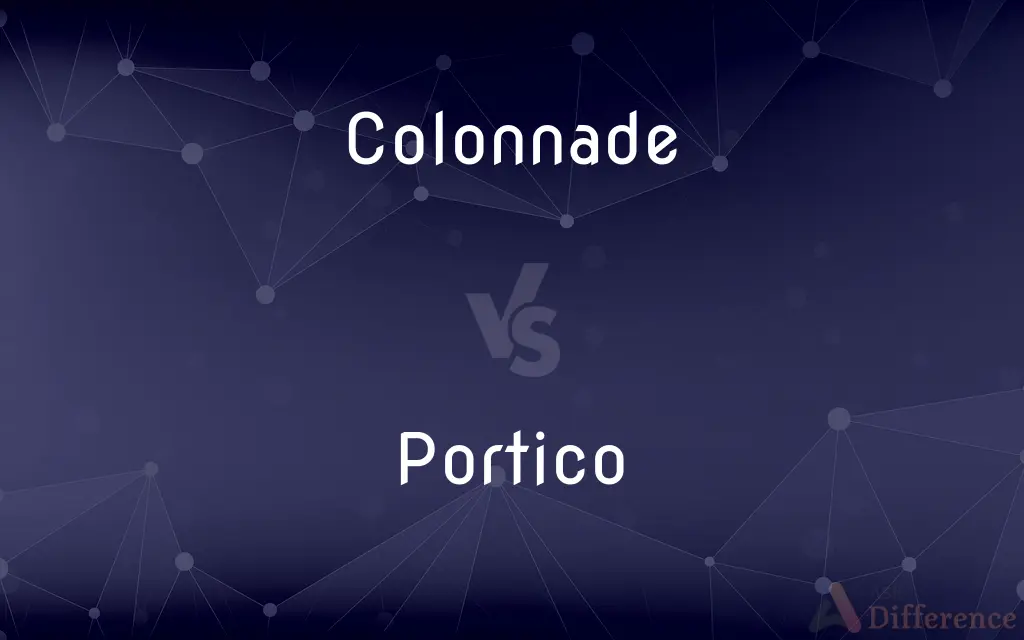Colonnade vs. Portico — What's the Difference?
Edited by Tayyaba Rehman — By Urooj Arif — Updated on March 29, 2024
A colonnade is a row of evenly spaced columns supporting an entablature, while a portico is a porch leading to the entrance of a building, often supported by columns.

Difference Between Colonnade and Portico
Table of Contents
ADVERTISEMENT
Key Differences
A colonnade consists of a series of columns spaced at regular intervals, often supporting a straight lintel (an entablature) or a series of arches (an arcade). A portico, on the other hand, is a specific architectural feature consisting of a porch or walkway with a roof supported by columns, leading to the entrance of a building. It serves both a practical function, protecting the entrance from the elements, and an aesthetic one, adding grandeur and an imposing quality to the façade.
Colonnades are used both for structural purposes and aesthetic appeal, providing a rhythmic, repetitive visual effect. They can be found in various parts of a building, including interiors, exteriors, and as part of a garden or courtyard design, reflecting classical architecture influences. Porticos are commonly associated with classical, Neoclassical, and colonial architecture, where they play a key role in defining the building's character and entrance.
While a colonnade can be part of a portico, indicating their complementary nature, the primary difference lies in their function and location. A colonnade is primarily a series of columns that can exist independently of a building's entrance, whereas a portico is specifically designed as an entrance feature. This distinction highlights the versatile use of columns in architecture, ranging from purely decorative to functional.
The design and implementation of colonnades and porticos also differ in terms of scale and context. Colonnades can extend for considerable lengths, as seen in historical sites like ancient Greek agoras or Roman forums, serving as covered walkways or part of a larger structural framework. Porticos, however, are more focused and localized, emphasizing the entrance area and serving as a transitional space between the exterior and interior.
Both elements have played significant roles throughout architectural history, adapting to various styles and periods. Their presence indicates a building's architectural lineage, whether drawing from ancient traditions or incorporating modern interpretations of classical elements. Understanding the nuances between a colonnade and a portico enriches one’s appreciation of architectural design and its historical contexts.
ADVERTISEMENT
Comparison Chart
Definition
A series of evenly spaced columns supporting a structure.
A covered entrance porch supported by columns.
Function
Structural support and decorative.
Provides entrance shelter and decorative appeal.
Location
Can be part of interiors, exteriors, or landscapes.
Specifically located at the entrance of a building.
Architectural Use
Used for creating walkways, dividing spaces, or decoration.
Used as a grand entrance feature.
Historical Context
Common in Greek and Roman architecture for various uses.
Integral to classical, Neoclassical, and colonial architecture as a focal entrance feature.
Compare with Definitions
Colonnade
A series of columns supporting an entablature.
The colonnade surrounding the Lincoln Memorial creates a majestic exterior.
Portico
A porch leading to a building's entrance supported by columns.
The White House features a prominent portico at its entrance, adding to its ceremonial appeal.
Colonnade
Reflects classical architecture influences.
The use of colonnades in modern courthouses evokes a sense of tradition and formality.
Portico
Designed to protect the entrance and add aesthetic appeal.
The portico of an old mansion may feature intricate column designs and a pediment.
Colonnade
Used to provide covered walkways or divide spaces.
Ancient Roman markets often featured colonnades to shade and separate different vendor areas.
Portico
Often associated with classical, Neoclassical, and colonial architecture.
Neoclassical buildings use porticos to emphasize symmetry and grandeur.
Colonnade
Columns placed at regular intervals for rhythmic visual effect.
The colonnades in Renaissance gardens provided aesthetic symmetry and structure.
Portico
Serves as a transitional space between exterior and interior.
The portico of a public library may offer shelter to visitors before entering.
Colonnade
Can be an interior or exterior architectural feature.
The interior colonnades in grand cathedrals help support the roof and enhance spatial dynamics.
Portico
Can include additional architectural elements like pediments.
Greek Revival homes often have porticos with triangular pediments, inspired by ancient temples.
Colonnade
In classical architecture, a colonnade is a long sequence of columns joined by their entablature, often free-standing, or part of a building. Paired or multiple pairs of columns are normally employed in a colonnade which can be straight or curved.
Portico
A portico is a porch leading to the entrance of a building, or extended as a colonnade, with a roof structure over a walkway, supported by columns or enclosed by walls. This idea was widely used in ancient Greece and has influenced many cultures, including most Western cultures.
Colonnade
A series of columns placed at regular intervals.
Portico
A porch or walkway with a roof supported by columns, often leading to the entrance of a building.
Colonnade
A structure composed of columns placed at regular intervals.
Portico
A porch, or a small space with a roof supported by columns, serving as the entrance to a building.
Colonnade
A series of columns at regular intervals.
Portico
A colonnade or covered ambulatory, especially in classical styles of architecture; usually, a colonnade at the entrance of a building.
Colonnade
A peristyle.
Portico
A porch or entrance to a building consisting of a covered and often columned area
Colonnade
A portico or stoa.
Colonnade
A regular row of anything, such as trees.
Colonnade
A series or range of columns placed at regular intervals with all the adjuncts, as entablature, stylobate, roof, etc.
Colonnade
Structure consisting of a row of evenly spaced columns
Colonnade
A structure composed of a series of arches supported by columns
Common Curiosities
What is the purpose of a portico in architecture?
A portico serves to shelter the entrance of a building and enhance its aesthetic appeal, often making a grand statement.
Can a portico have a colonnade?
Yes, a portico can feature a colonnade as part of its structure, where the columns support the roof of the entrance porch.
What is a colonnade?
A colonnade is a row of columns supporting a straight lintel or series of arches, used for both structural and decorative purposes.
What historical significance do porticos have?
Porticos have been important in architecture since ancient times, symbolizing power, welcome, and protection, particularly in Greek and Roman cultures.
What architectural styles commonly use colonnades?
Classical, Neoclassical, Renaissance, and Baroque architectures often feature colonnades for aesthetic and functional purposes.
What materials are commonly used for columns in porticos?
Columns in porticos are commonly made from stone, marble, wood, or composite materials, depending on the architectural style and era.
How does a portico differ from a colonnade?
A portico is a covered entrance porch supported by columns, specifically designed as an entrance feature, whereas a colonnade is a series of columns that may serve various functions beyond an entrance.
How do colonnades affect a building's design?
Colonnades can influence a building's aesthetic, creating patterns of light and shadow, adding rhythm, and defining spaces within and around a structure.
Can modern architecture incorporate colonnades and porticos?
Yes, modern architecture can incorporate these elements, often with a contemporary twist that respects traditional forms while innovating in materials and design.
Are colonnades only used outdoors?
No, colonnades can be used indoors as well, such as in large halls or as part of interior design to divide spaces or add decorative elements.
Is there a functional benefit to having a colonnade in a building?
Beyond aesthetics, colonnades can provide structural support, divide spaces effectively, and offer shaded walkways, enhancing both utility and comfort.
How has the use of colonnades evolved over time?
While initially used in ancient temples and public spaces for practical and ceremonial purposes, colonnades have evolved to play diverse roles in various architectural styles, blending functionality with beauty.
What makes porticos distinct in colonial architecture?
In colonial architecture, porticos are distinct for their symmetry, simplicity, and the way they echo classical principles, serving as a signature element of the style.
What types of buildings commonly feature porticos?
Government buildings, museums, mansions, and historical homes are among the types of buildings that commonly feature porticos.
How do porticos contribute to the character of historical buildings?
Porticos add a sense of grandeur and formality to historical buildings, often reflecting the architectural ideals of their time.
Share Your Discovery

Previous Comparison
Mawkish vs. Twee
Next Comparison
Megaohm vs. MegohmAuthor Spotlight
Written by
Urooj ArifUrooj is a skilled content writer at Ask Difference, known for her exceptional ability to simplify complex topics into engaging and informative content. With a passion for research and a flair for clear, concise writing, she consistently delivers articles that resonate with our diverse audience.
Edited by
Tayyaba RehmanTayyaba Rehman is a distinguished writer, currently serving as a primary contributor to askdifference.com. As a researcher in semantics and etymology, Tayyaba's passion for the complexity of languages and their distinctions has found a perfect home on the platform. Tayyaba delves into the intricacies of language, distinguishing between commonly confused words and phrases, thereby providing clarity for readers worldwide.
















































